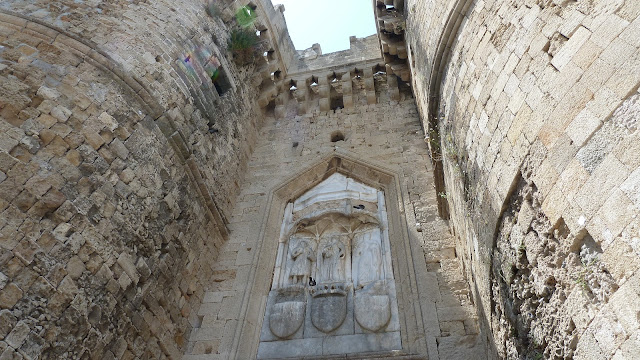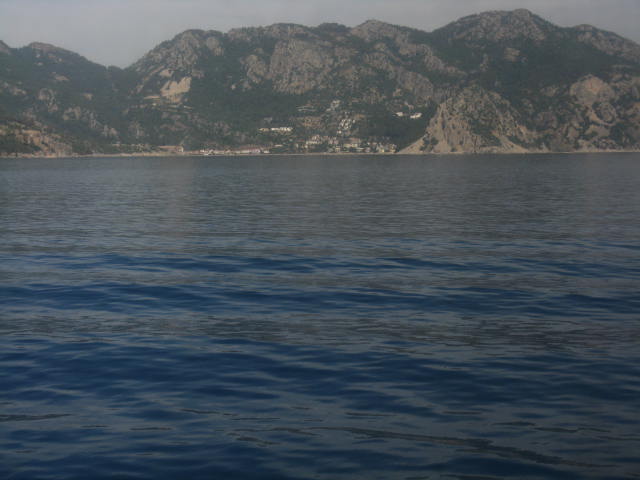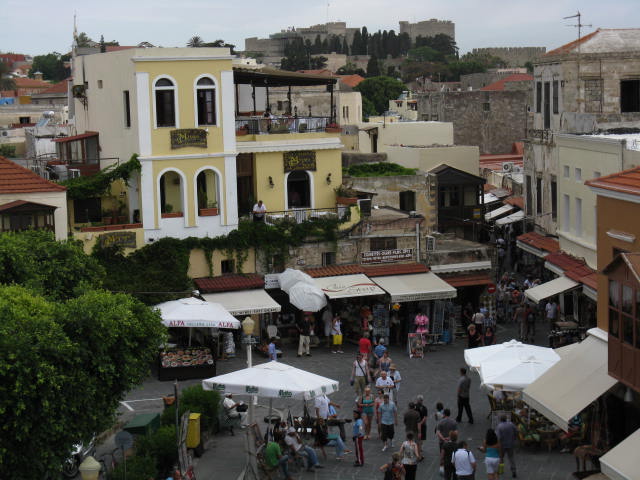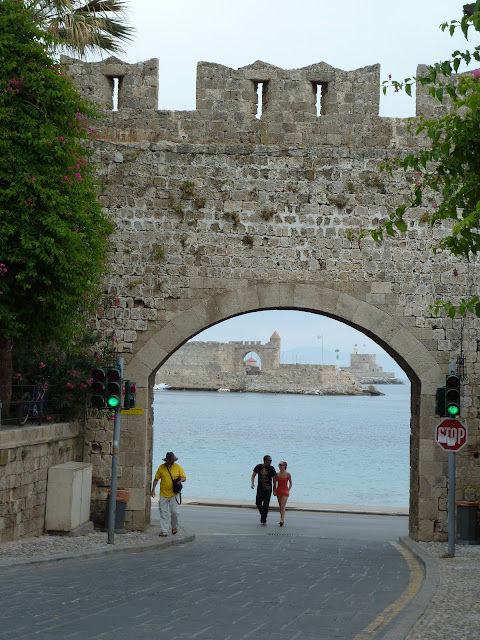Rhodes City: Port da la Marine Gates in Mandraki Harbor
This was our destination - these handsome fortifications and other historical sights in Rhodes City on the Greek island of Rhodes, about 2 hours or 50 km. from the Turkish mainland by ferry. We decided to introduce a break into the Turkish vacation itinerary and make a quick dash by ferry across the water to Rhodes where we spent 2 nights.
Rhodes City (Greek: Ρόδος) is the principal city on the island of Rhodes in the Dodecanese islands of Greece. It has a population of approximately 50,000 inhabitants.
Red dots: I've marked the location of Marmaris, Turkey, and Rhodes City, Greece, on the island of Rhodes. Note the route the ferry took across the Aegean Sea to travel between them. (Turkey is colored grey, and Greece is yellow.)
Wikipedia
The fortress of Rhodes, built by the Hospitalliers, one of the best-preserved medieval towns in Europe, was designated in 1988 as a UNESCO World Heritage Site.
Today, Rhodes is a popular international tourist destination.
Rhodes was also famous in antiquity as the site of the Colossus of Rhodes, one of the Seven Wonders of the Ancient World. I'll share about that later in this blog.
 |
| http://www.doncronerblog.com/2016/06/greece-island-of-rhodes-rhodes-old-town.html |
Above, the city walls are impressive - indicating the important strategic military role it played in Medieval Eastern Mediterranean history. If you get a chance to travel to Rhodes, try to read about its history before you visit - you'll have a richer experience. Below is a medieval sketch to show you what the city was like before damage from bombardment and destruction from siege warfare.
Above, a close-up shows the harbor and gates. If you arrive at Rhodes City by ferry, this is the place you will dock.
Rhodes City square on a summer night. We enjoyed dinner at just such a location, above street-level on the first floor.
And now let's turn our attention back to Marmaris for a few minutes, back in Turkey - our launching place - to continue the story.
Here is what we saw when we drove into Marmaris on the previous day before our ferry trip... a city set in a very mountainous coastline with a nice harbor. We toured the waterfront a bit, and then drove 25 minutes through mountainous terrain to get to our overnight accommodations.
Because Marmaris had a reputation for being a "party town," I choose to spend our night in a quieter environment a few kilometers away. Such a destination looked suitable and easy to reach on a map - from a vertical perspective - but turned out it required a lot of rigorous driving over the hills, which I was not prepared for in terms of time. We drove into the sunset...
...on the way to our hotel at Hisaronu, located above the green pin on the map, below.
The road took us across the hills far above the Marmaris (located in the bay on the right) and then down into another harbor with several hotels (the large bay on the left). |
| Cliff_Emerson© |
Harbor in Marmaris
We crossed the sea on the vessel in the foreground.
We're off! On our ferry, heading for the island of Rhodes. Looking back, you can see the harbor of Marmaris (Turkey) and the tall surrounding hills. We obviously needed our passports for this short jaunt to go between countries.
 |
| https://classicalwisdom.com/culture/sculpture/the-colossus-of-rhodes-coming-back-to-life/ |
A bit of history:
After Antigonus I LINK, the head of neighboring Cyprus, an island to the east, unsuccessfully attempted to lay siege to Rhodes in 305-304 BC, the people of Rhodes decided to honor their patron sun god, Helios.
In 292 B.C., Greek sculptor Chares began construction on the Colossus. For twelve years, workers forged iron and bronze from military weapons that were left behind to create the outer shell of the statue. The body was probably filled with stones.
As construction increased in height, historians believe the workers built long ramps of earth and rocks to surround the Colossus and reach the upper levels. Upon completion, the material was removed.
 |
| https://7wonders.org/europe/greece/rhodes/colossus-of-rhodes/ |
The 108-foot tall statue of Helios stood on a 49-foot tall white marble pedestal, putting the height of the Colossus of Rhodes at an impressive 157-feet.
In 226 B.C., after 54 years of standing, Rhodes was hit by a devastating earthquake that snapped the colossus at its knees, causing it to fall over. What a horrible disaster!
 |
| https://www.worldation.com/nature/the-colossus-of-rhodes/ |
[Above, an artist's modern rendition of that sad sight of a broken colossus leg and foot!]
Ruling members of the city spoke of rebuilding, but some citizens who consulted the Oracle of Delphi (located north on the mainland in Achaia, Greece) warned against it. (Learn about oracles on another blog posting LINK.)
Apparently, the people of Rhodes had clearly offended the god, Helios, and this caused the statue to fall. Rebuilding it could result in even more serious damage!
 |
| https://www.greece-is.com/the-mystery-of-the-colossus-of-rhodes/ |
Although it lay in pieces, the Colossus of Rhodes was still impressive. For 800 years, people traveled from far and wide to come see the pieces in the harbor. Pliny the Elder wrote that visitors were stunned at its sheer size, noting that people could barely wrap their arms around its thumb and that its fingers were taller than most statues.
In 693, the Muslim caliph Muawiyah I stormed Rhodes and captured the island. According to the Chronicle of Theophanes the Confessor, pieces of the statue were melted down thereafter and sold to a Jewish merchant, who loaded them onto 900 camels and took them away. (I would have liked a piece for my souvenir collection!)
 |
| https://greekreporter.com/2017/11/06/the-colossus-of-rhodes-6-facts-about-one-of-the-wonder-of-the-ancient-world/ |
>>How Chares crafted the Colossus, therefore, with cast or hammered sections of bronze, remains a mystery. Iron braces were likely employed for internal reinforcement, but still the statue proved short-lived, ultimately collapsing during an earthquake in 226 BC. Noting its size, hollowness and construction, Pliny wrote: “Few men can clasp the thumb in their arms, and its fingers are larger than most statues. Where the limbs are broken asunder, vast caverns are seen yawning in the interior. Within it, too, are to be seen large masses of rock, by the weight of which the artist steadied it…”
Here's a really good YouTube:
Where the Colossus stood also remains a question. Medieval artists depict it astride the entrance to Rhodes’ port, one foot on the terminus of each breakwater. Some scientists believe that technical considerations would have made this location impossible, but a distinctive circle of stones and finely-carved marble blocks reused in the 15th c. St. Nicholas Tower at the mouth of Mandraki Harbor may indicate that the position of the base and statue had been there. Alternatively, the Rhodian acropolis has also been proposed as a possible location. (high on the other side of Rhodes City.)
 |
| http://www.rhodesguide.org/ |
Today, a debate rages in debt-torn Greece whether a new Colossus of Rhodes should be erected.<<
https://www.greece-is.com/the-mystery-of-the-colossus-of-rhodes/
In 2015, tentative plans were drawn up, and this is a possible prototype.
 |
| https://classicalwisdom.com/culture/sculpture/the-colossus-of-rhodes-coming-back-to-life/ Here is a reasonably good video about the Colossus of Rhodes, if you are still curious: |
 |
| https://brewminate.com/the-seven-wonders-of-the-ancient-world-digitally-reconstructed/ |
 |
| Cliff_Emerson© |
 |
| Cliff_Emerson© |
 |
| Cliff_Emerson© |
 |
| http://www.rhodesguide.org/ |
The Templar Castle as seen from the harbor
Here's a detailed map of the old city and harbor.
 |
| http://ontheworldmap.com/greece/city/rhodes/rhodes-city-old-town-map.html |
The map above shows the old section of Rhodes City. Notice the wall sections (brown) which have survived and were not torn down (as you'll find in many European cities). Our ferry docked in the upper-right part of the harbor which is labled the "touristic harbour" on the map.
 |
| http://ontheworldmap.com/greece/city/rhodes/rhodes-city-old-town-map.html |
Above, a close-up view of the old city, inner harbor area. The pink rectangle is the Knights Templar Palace. LINK
 |
| http://www.lovegreekislands.com/rhodes-map.html |
The Knights of Rhodes of St. John captured Rhodes in 1309. In the Old Town, where they established their administrative center, there was already a fortified Byzantine settlement occupying 175,000 square meters built on the site of an ancient city that dated back to 408 BC.
The Knights expanded the area of the town walls and protected it with three lines of defensive fortifications. However, they handed it over to the Ottomans after a long siege in 1522.

cliff_emerson
Here's a quotation from Wikipedia dealing with the earlier Ottoman Siege of 1480:
Attack
On 23 May 1480 an Ottoman fleet of 160 ships appeared before Rhodes, at the gulf of Trianda, along with an army of 70,000 men under the command of Mesih Pasha. The Knights Hospitaller garrison was led by Grand Master Pierre d'Aubusson.

The Ottomans' first goal was to capture the Tower of St Nicholas, a strategic point for the knights' defense of the two harbors: Mandraki, and the one to the east bay of Akandia.
The Turkish artillery kept up an unbroken bombardment and, from 9 June on, the infantry made a series of attacks. Grand Master d'Aubusson himself sped to the aid of the garrison and the enemy was repelled after a fierce struggle.
A second attack on the town occurred on the eastern sector of the wall near the Jewish quarter, towards the bay of Akandia, which was the battle station of the "tongue" of Italy and was quite weak.
The Knights and townspeople dug a new moat on the inside of the wall at this point and constructed a new internal fortification, while bombardment from the Turkish artillery continued. Once again the Knights defended the town, and after a bitter battle with many casualties on both sides, the danger was once more averted.
 |
| https://www.greece-is.com/rhodes-land-castles-age-crusaders/ |
At dawn on 27 July, the Turks launched a vigorous offensive and their vanguard of around 2,500 Janissaries managed to take the tower of Italy and enter the city. A frenzied struggle ensued.
The grand master, wounded in five places, directed the battle and fought with lance in hand. After three hours of fighting the enemy were decimated and the exhausted survivors began to withdraw. The Knights´ counter-attack caused the Turks to beat a disorderly retreat, dragging along with them the Vizier and commander-in-chief. The Hospitallers reached as far as his tent and took, along with other booty, the holy standard of Islam. On that day, between three and four thousand Turks were slain.
On August 17, 1480, the Ottoman fleet gave up their attempt to capture Rhodes. Sultan Mehmed II was furious and would have attacked the island again, but his death in 1481 put a stop to the attempt. In 1521-22 the Ottomans besieged Rhodes once again and this time captured the city and entire island.
 |
| cliff_emerson© |
 |
https://www.greece-is.com/old-town-rhodes/ |
 |
| cliff_emerson |
Destroyed Medieval Church
 |
| cliff_emerson© |









































